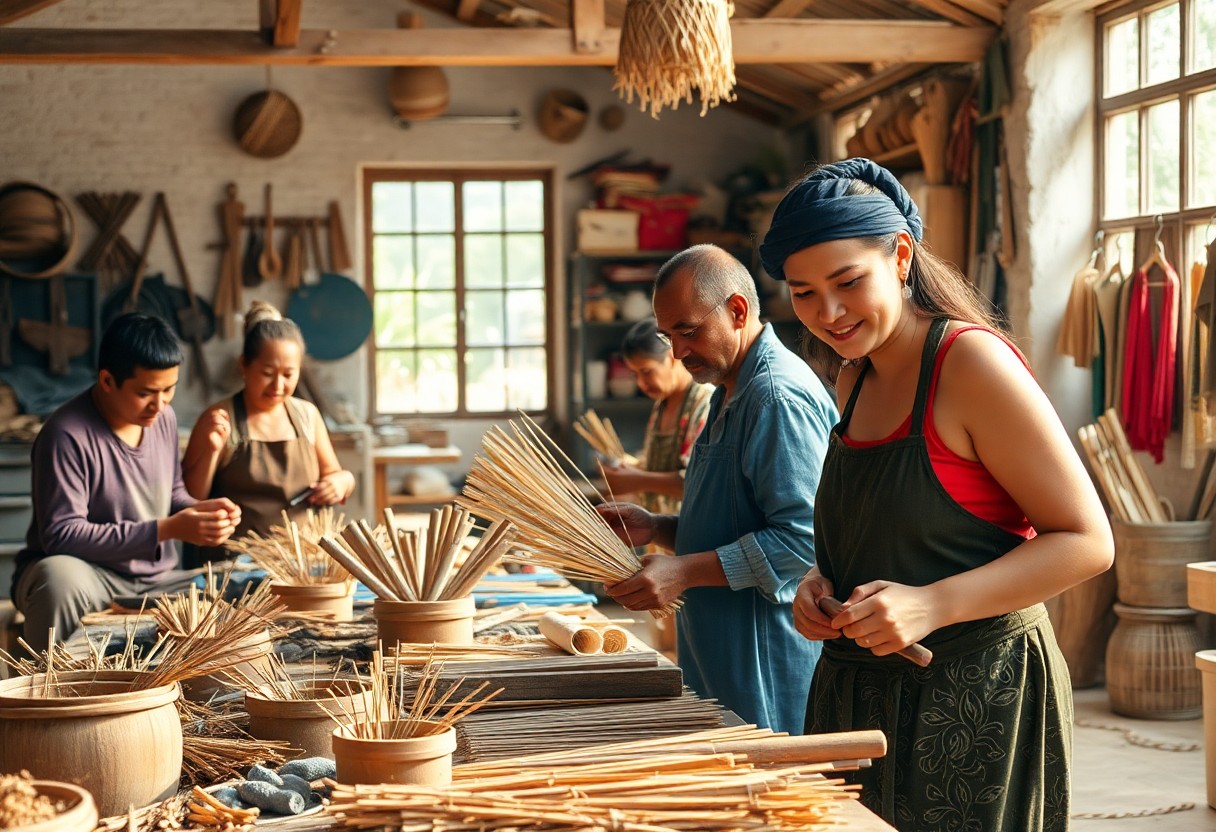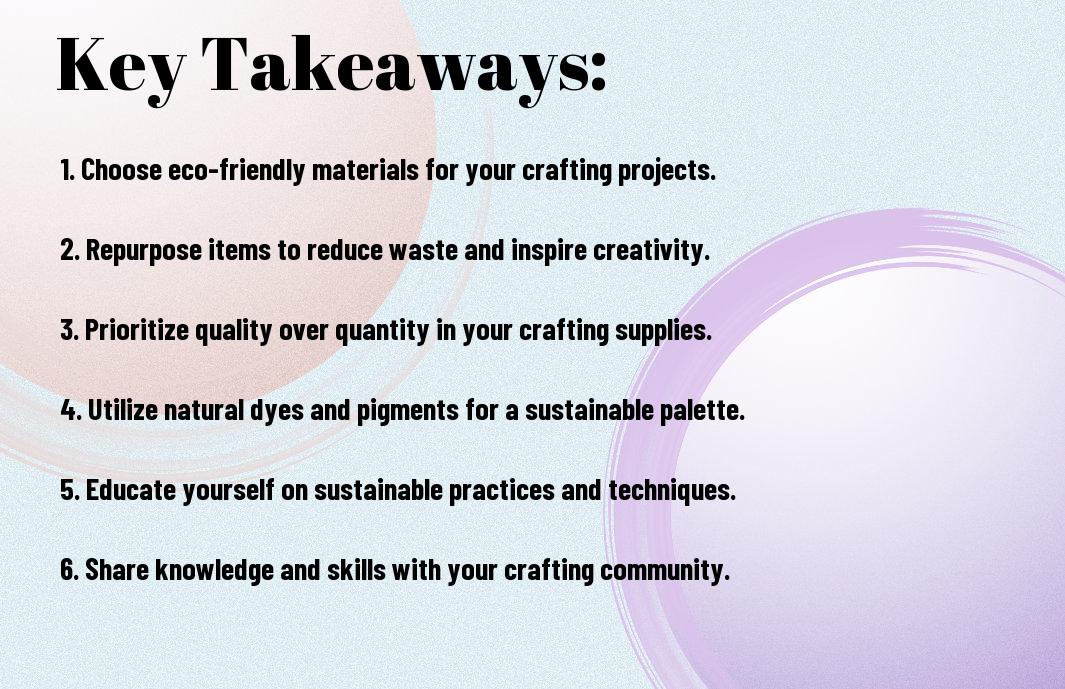As you explore the world of crafting, you’re likely considering the environmental impact of your creative pursuits. You can make a positive difference by adopting sustainable practices in your craft room. To get started, you’ll need to source eco-friendly materials, and learning How To Get Materials For Sustainable Crafts is an necessary step. By doing so, you’ll be well on your way to reducing your carbon footprint and creating unique, environmentally conscious pieces that reflect your values.

Key Takeaways:
- The practice of sustainable crafting involves being mindful of the environmental impact of our creative activities, and making conscious choices to reduce waste and minimize harm to the planet.
- By adopting eco-friendly techniques and using recycled materials, crafters can create unique and beautiful pieces while also promoting sustainability and reducing their carbon footprint.
- Embracing the slow crafting movement can help crafters develop a more thoughtful and intentional approach to their work, allowing them to create meaningful and lasting pieces that bring joy and fulfillment to both the maker and the user.
The Importance of Sustainable Crafting
Before you start your crafting journey, it’s crucial to consider the impact of your creative pursuits on the environment and society. By choosing sustainable crafting practices, you can significantly reduce your ecological footprint and contribute to a more responsible crafting community.
Environmental Benefits
Sensibly, you can make a significant difference by adopting eco-friendly crafting methods, such as using recycled materials, minimizing waste, and opting for sustainable supplies, which can help reduce your environmental impact and preserve natural resources for future generations.
Social Responsibility
Beyond your individual actions, you are part of a larger crafting community that can collectively make a positive impact on society, and by supporting fair trade practices, donating to charitable causes, and promoting inclusivity, you can help create a more equitable and compassionate crafting world.
For instance, when you choose to support local artisans and small businesses, you are directly contributing to the well-being of your community, and by doing so, you are also promoting cultural heritage and traditional craftsmanship, which can have a lasting impact on the social fabric of your society, and as you continue to craft, you can take pride in knowing that your hobby is not only a source of personal fulfillment but also a force for good.

Choosing Eco-Friendly Materials
Any craft project begins with selecting the right materials, and as someone who cares about the environment, you want to make choices that minimize your impact. You can start by exploring alternatives to traditional materials and considering the environmental effects of your selections.
Natural Fibers
Following your decision to go eco-friendly, you’ll find that natural fibers like cotton, hemp, and bamboo are excellent options for your crafting needs. You can use these materials to create a wide range of items, from clothing and accessories to home decor and furniture.
Recycled Resources
Beyond the obvious choices, you’ll discover that recycled resources can add a unique touch to your crafts. You can repurpose old items like plastic bottles, cardboard tubes, and fabric scraps to create innovative and eco-friendly pieces.
Indeed, using recycled resources in your crafting not only reduces waste but also allows you to get creative and think outside the box. You can transform old materials into new, functional items, such as turning old t-shirts into reusable bags or creating jewelry from recycled glass. As you explore the world of recycled resources, you’ll find that the possibilities are endless, and your crafting will become more sustainable and inspiring.
Minimal Waste Design
Now, as you commence on your sustainable crafting journey, consider the impact of your design choices. You can significantly reduce waste by selecting patterns and materials that generate minimal scraps, allowing you to create beautiful pieces while minimizing your environmental footprint.
Zero-Waste Patterns
Among the various strategies for reducing waste, zero-waste patterns are an excellent place to start. You can find or create patterns that use the entire piece of fabric, leaving no scraps behind, and enabling you to make the most of your materials.
Repurposing Old Materials
After mastering zero-waste patterns, you can take your sustainable crafting to the next level by repurposing old materials. You can breathe new life into old items, such as turning old t-shirts into reusable bags or transforming plastic containers into planters, giving you a sense of creativity and fulfillment.
Minimal waste is all about being mindful of your materials and finding innovative ways to reuse them. As you explore deeper into repurposing old materials, you’ll discover that your imagination is the only limit to what you can create. You’ll be able to transform old, discarded items into unique, functional pieces that not only reduce waste but also tell a story, making your crafting experience even more rewarding and enjoyable.
Community Involvement
Your involvement in the community can greatly impact the sustainability of your crafting practices, and there are many ways to get started, from participating in local crafting groups to supporting eco-friendly initiatives.
Collaborative Crafting
Similarly, one of the most effective ways to promote sustainability is by working together with others, sharing ideas and resources to minimize waste and maximize creativity in your crafting projects.
Supporting Local Artists
Anyway, an excellent way to contribute to the sustainability of your community is by supporting local artists and craftspeople, purchasing their handmade goods and promoting their work to others.
Even as you continue to support local artists, you’ll find that your actions have a positive impact on the local economy and help to preserve traditional crafting techniques, allowing you to feel more connected to your community and the items you craft and purchase.
Innovative Techniques
After exploring the basics of sustainable crafting, you can now examine innovative methods that will take your craft to the next level. You’ll discover new ways to transform materials and create unique pieces that showcase your skill and creativity.
Upcycling
Ingenious approaches to upcycling allow you to breathe new life into old materials, giving you the opportunity to create one-of-a-kind items that tell a story. You can turn discarded objects into functional pieces, reducing waste and adding character to your craft.
Eco-Dyeing
Inventive eco-dyeing techniques enable you to achieve vibrant colors while minimizing your environmental impact. You can experiment with natural dyes, such as plant-based extracts, to create a distinctive and sustainable palette for your craft projects.
Further exploration of eco-dyeing reveals a world of possibilities, as you can use various natural materials like leaves, flowers, and spices to create a wide range of colors and patterns. You can also experiment with different binding agents and mordants to achieve unique shades and hues, allowing you to develop your own signature style and take your sustainable crafting to new heights.
Preserving Traditional Crafts
To appreciate the value of sustainable crafting, you need to understand the importance of preserving traditional crafts. You can do this by learning about the history and techniques behind these crafts, and by supporting artisans who continue to practice them.
Heritage Skills
Protecting traditional crafts involves preserving heritage skills that have been passed down through generations. You can help by learning these skills yourself, or by supporting organizations that work to preserve them, allowing you to connect with your cultural heritage.
Cultural Significance
Towards understanding the cultural significance of traditional crafts, you should consider the role they play in your community and your life. You can explore how these crafts reflect the history and values of your culture, and how they contribute to your sense of identity.
Traditional crafts hold a special place in your cultural heritage, and by engaging with them, you can deepen your understanding of your roots. You can learn about the symbolism, myths, and legends surrounding these crafts, and appreciate the stories they tell about your ancestors and their way of life, enriching your connection to your cultural heritage.
Summing up
As a reminder, you now have the knowledge to begin on your sustainable crafting journey. You can apply your skills to reduce waste and create unique pieces. Your contribution to a more eco-friendly craft practice is valued, and you will see the positive impact on your surroundings. You will continue to learn and grow, shaping your craft into a reflection of your commitment to sustainability.
FAQ
Q: What is sustainable crafting and how does it benefit the environment?
A: Sustainable crafting refers to the practice of creating handmade products using eco-friendly materials, techniques, and processes that minimize waste and reduce environmental impact. This approach to crafting benefits the environment by conserving natural resources, reducing carbon footprint, and promoting the use of recycled or repurposed materials. By adopting sustainable crafting practices, individuals can contribute to a more environmentally conscious lifestyle and help mitigate the negative effects of climate change.
Q: What types of materials are used in sustainable crafting?
A: Sustainable crafting often involves the use of natural, biodegradable, and recycled materials, such as repurposed wood, bamboo, organic cotton, hemp, and plant-based dyes. Additionally, crafters may use materials that would otherwise be discarded, like old maps, book pages, and fabric scraps, to create unique and innovative products. The focus is on using materials that are gentle on the environment and can be sourced locally, reducing transportation emissions and supporting local economies.
Q: How can I get started with sustainable crafting and what skills do I need?
A: To get started with sustainable crafting, you don’t need to have extensive crafting experience, but rather a willingness to learn and experiment with new techniques and materials. Basic skills like sewing, knitting, or woodworking can be beneficial, but many sustainable crafting projects involve simple, low-tech methods that can be learned through online tutorials or workshops. Start by exploring different sustainable crafting techniques, such as upcycling, repurposing, or natural dyeing, and practice with readily available materials to develop your skills.
Q: Can sustainable crafting be a viable business or income source?
A: Yes, sustainable crafting can be a viable business or income source, as there is a growing demand for eco-friendly, handmade products. Many consumers are willing to pay a premium for unique, high-quality items that are made with sustainable materials and practices. To turn your sustainable crafting hobby into a business, focus on developing a distinctive brand, building a strong online presence, and engaging with customers who share your values. You can sell your products through online marketplaces, craft fairs, or local shops, and consider offering workshops or classes to teach others about sustainable crafting techniques.
Q: How can I ensure that my sustainable crafting practices are authentic and effective?
A: To ensure that your sustainable crafting practices are authentic and effective, it’s imperative to adopt a holistic approach that considers the entire lifecycle of your products, from sourcing to end-of-life. Be transparent about your materials, methods, and supply chain, and continuously assess and improve your practices to minimize waste and environmental impact. Stay informed about new sustainable materials, technologies, and techniques, and engage with the sustainable crafting community to share knowledge, resources, and best practices. By being committed to ongoing learning and improvement, you can create beautiful, functional products that not only delight your customers but also contribute to a more sustainable future.
